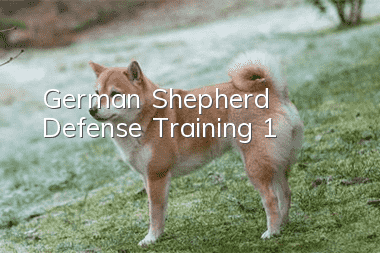German Shepherd Defense Training (1)

It is indeed not easy to raise a purebred German Shepherd in China. It is not enough to just keep it as a general pet. To fully demonstrate the charm and instinct of a German Shepherd, the key is to treat the dog actively and effectively. ground training. Never think that this kind of dog is smart and tame, and just doesn't bite or scratch on the surface. In fact, systematic and formal training of German Shepherds has a history of 100 years. People have accumulated a lot of training experience. If dog owners understand this knowledge, they will further increase the number of people raising such large dogs. fun of. The highest state of dog breeding is for humans and dogs to achieve a high degree of harmony, and formal and systematic defense training for dogs is the only way to achieve this state.
What is "defense training"
Many people have misunderstandings about dogs receiving defense training. They believe that dogs that have been trained for defense are more ferocious and dangerous than dogs that have not been trained. Or they think that allowing dogs to receive defense training will make dogs more ferocious and dangerous. This is completely wrong. Incorrect.
In fact, "defense" means to avoid and prevent attacks, which is exactly the opposite of the possibility of being attacked. A defense-trained German Shepherd knows exactly when to bite and when not to bite; and can tell the difference between an innocent pedestrian or child and a stick-wielding gangster. This kind of dog can absolutely obey the owner's orders and obey the owner's instructions under any circumstances.
In addition, German Shepherd’s defense training is still the most important part of its breeding system. In Germany, it is unthinkable to breed a dog that has not been trained for defense. The minimum requirement for a breeding dog is to pass the defense level 1 or shepherding examination, plus meet some other basic requirements in the breeding rules. At present, there is a widespread tendency in China to focus on breeding rather than training, and blindly breed to make money, which is likely to lead to the degeneration of the German Shepherd breed. In short, only dogs that meet the breeding requirements after training and examination can be bred, thereby ensuring the healthy development of German Shepherd dogs.
The origin of defense training
Defense training was formed in Germany around 1900. At that time, Mr. Stefanitz, the founder of the German Dog Association, only wanted to optimize the breed, but soon he tried to develop a defense training plan suitable for police requirements. In 1903, the German Kennel Federation officially conducted working dog training for the first time. These experiments soon became the evaluation standards for breeders of police dogs and other types of working dogs. Soon, a formal training system for German shepherd dogs was formed on this basis, which is now known as "defense training."
Since then, other new dog sports clubs and related organizations have been derived from the concept of "defense training" in Germany and many parts of the world, whose purpose is to train dogs throughTraining in specialized work subjects in order to identify and select dogs with the best character (temperament) for breeding.
Contents of defense training
Defense training usually includes three parts: walking on designated routes, obeying commands and basic defense techniques. Generally speaking, to judge the quality of a working dog, you can see the dog's character, psychological stability, endurance, physical coordination, olfactory sensitivity, work desire and courage, and training ability through defense training. In addition, after defense training and testing, a conclusion can be made on the overall quality of the dog, as a result of whether the dog has the conditions to become a breeding dog.
As a sport, defense training undoubtedly gives dog owners an opportunity to train their dogs specifically. During the training, the owner's training ability and the dog's ability to perform training will be fully reflected. Through such contact, not only can humans and dogs It deepens friendship and can further develop and strengthen the dog's interest in work. In fact, many people abroad, including people of different ages and backgrounds, like and even love this sport very much, and even regard it as a hobby. The whole family often participates in it, and when conditions permit, performances and competitions are also held.
Three parts of defense training
1. Search along the designated route: This is the first step in defense training. If you don’t know much about dogs in advance, you must carefully check the dog’s ear number before training to see if the dog has been registered and has a formal breeding record. In addition, it is best to observe the dog's mental state from a distance to determine whether the dog's psychology is stable. The trainer can usually leave the leash loose and approach the dog naturally, and if the dog is not shy or aggressive, the training can proceed. If the dog is too receptive, avoids, or has a strong tendency to attack, it means that the dog has a mental condition problem or an unsatisfactory character (temperament), and there is no basis for training.
Determining a dog's walking route is very simple, as long as a person walks a certain distance on an ordinary piece of land or grass. But this person needs to set a certain number of turns and some special small objects on the road he travels. The latter usually can use some credit card-like cards. Of course, these cards must be placed on the road by the person himself. Once set up, the handler can guide the dog on its way. The trainer can lead the dog with a 10-meter-long leash and try to loosen the leash as much as possible. Let the dog identify the path by smelling the former's footprints, and at the same time let the dog identify the small objects set in advance. The method of identification is usually to let the dog lie down first and put a small object between the dog's two paws. After the dog remembers it, it can officially start walking. The focus of this kind of training, which allows the dog to walk along a designated route, is to test the dog's ability to accept training, its sense of smell, as well as its psychological quality and physical endurance.
2. Command obedience: The training focus of this project is to let the dog perform a series of following training, mainly to let the dog approach and follow a group of people. In the process of followingIn this case, a person can intentionally fire a gunshot. At this time, the dog should ensure that there is no excessive frightened reaction and no harsh barking. At the same time, command obedience training also includes a series of training on receiving commands in situ, mainly including sit down, lie down, stand up, etc. In addition, if the dog does not stay in place after the trainer changes the location, the dog should still follow the command given by the trainer as usual. The dog cannot refuse to execute a command due to a change in the trainer's position.
It should also be noted that when training, the trainer should ask the dog to lie down at a certain distance from the trainer. Even if the trainer is playing with other dogs on the other side of the training venue, the dog should still be on the ground. Stay in a prone position there. Of course, all this obedience training is a test of the dog's character (temperament), effectiveness of body structure, and desire to work.
3. Basic defense techniques: The training of basic defense techniques focuses on testing the dog’s courage, physical strength and agility, as well as the owner’s control of the dog. These trainings include: searching for hidden objects, discovering hidden people, and guarding the "target person" until the dog owner arrives; when the target person attempts to escape, the dog must have the desire to pursue and bite the "target person" with a sheath. The arms are held until the "target person" is escorted by the dog and owner to the referee. If the "target person" attempts to attack the dog owner again, the dog must bite the "target person" without hesitation and resolutely stop him from infringing the dog owner.
The last is a test of courage. When the dog owner asks the "target person" to run out of the hiding place at the other end of the training ground (usually 50 steps away), the dog must quickly catch up with the "target person". Before the dog is about to catch up to the "target person", the referee gives a signal to the "target person", and the "target person" immediately turns around, rushes directly to the dog, yells at the dog loudly, and takes out a stick to threaten the dog. At this time, the dog should show Fearless courage to attack the "target person" until he bites and subdues the "target person".
In addition, defense training also emphasizes that once the "target person" stops escaping and the dog owner issues a stop command, the dog must immediately let go and no longer attack the "target person". Therefore, defense training can confirm whether the dog is timid and fearful, and whether it can unconditionally accept the control of the trainer under any conditions. This is crucial to the quality of the dog.
- How should I raise a Husky puppy when it is one month old?
- Border Collie Price | Training | Introduction
- How big should Teddy be vaccinated?
- What will happen if puppies eat adult dog food?
- How to treat fungal skin diseases in dogs?
- What should I do if my Labrador has body odor?
- How to train an English Bulldog to swim
- Prevention and Treatment of Dog Gastroenteritis Symptoms
- How long does it take for a dog’s surgical wound to return to normal?
- Does raising a dog require a dog crate?



